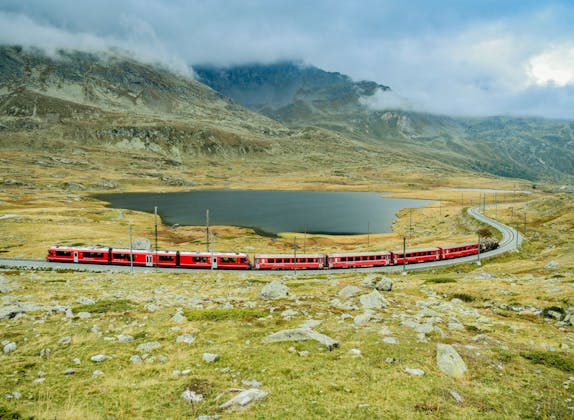
Ticket for the Bernina Route
Validity: All day

7 Activities
Filter
Better than 4.5 stars
Better than 4 stars
Better than 3.5 stars
Better than 3 stars
No Rating

Ticket for the Bernina Route
Validity: All day

Lucerne - Interlaken Express Ticket (without reservation)
Validity: All day
Why book with Swiss Activities?

Centovalli train ticket between Domodossola and Locarno
Validity: All day

Voralpen Express Ticket from St. Gallen or Lucerne
Validity: All day

Golden Pass Express Ticket from Interlaken Ost or Montreux (without reservation)
Validity: All day
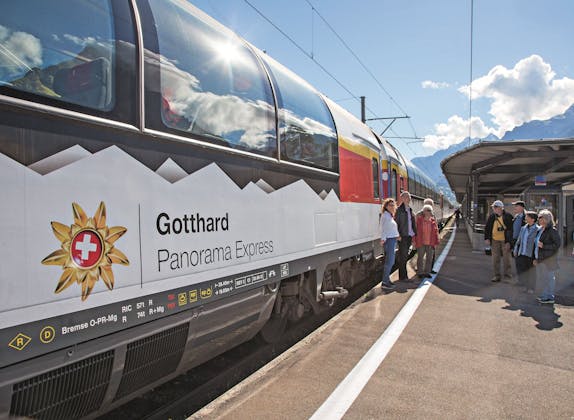
Gotthard Panorama Express Ticket from Lucerne or Lugano (without seat reservation)
Validity: All day

Glacier Express Ticket from St. Moritz or Zermatt (without reservation)
Validity: All day
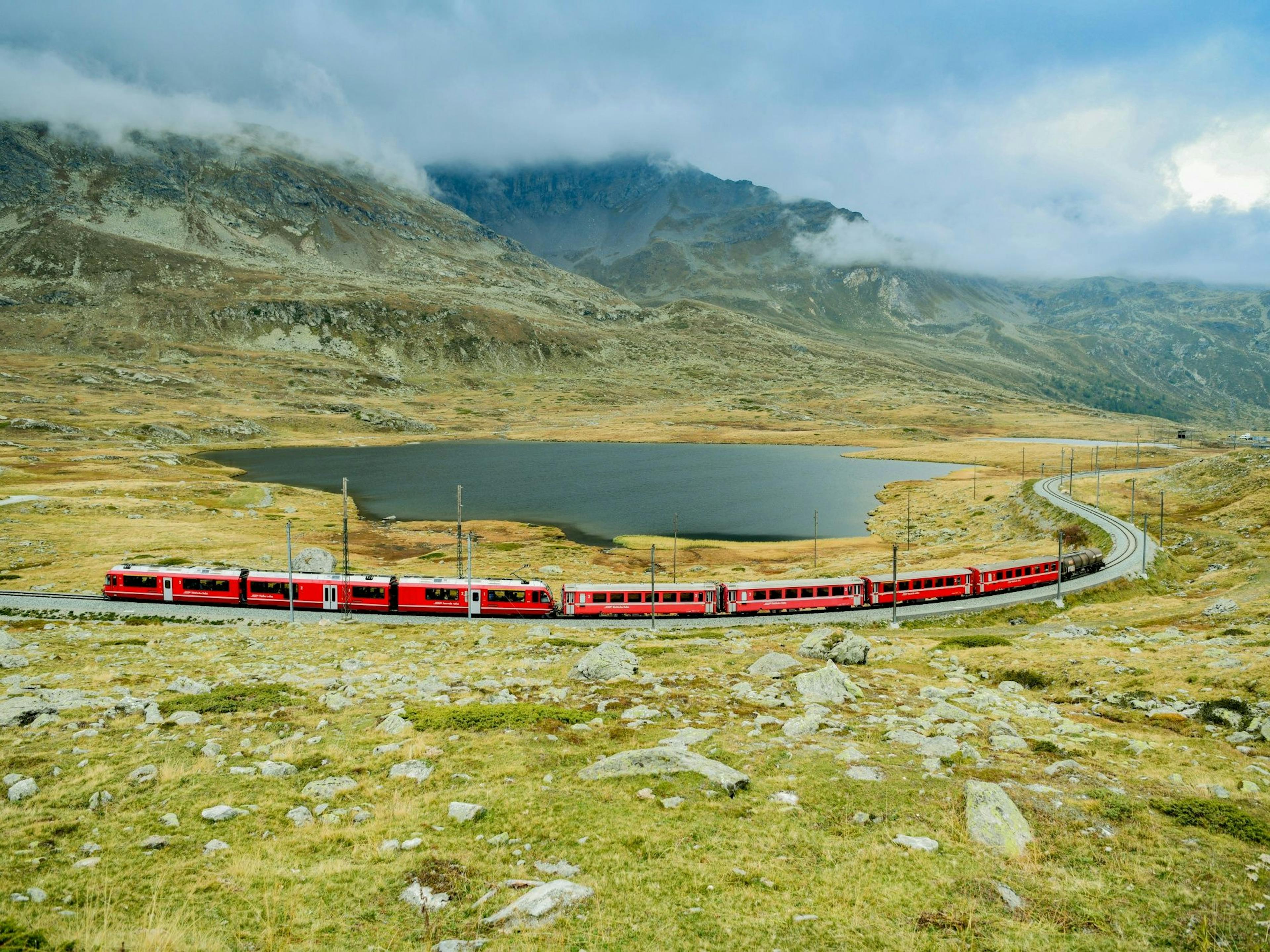
Ticket
High demandTicket for the Bernina Route
booked 114 times
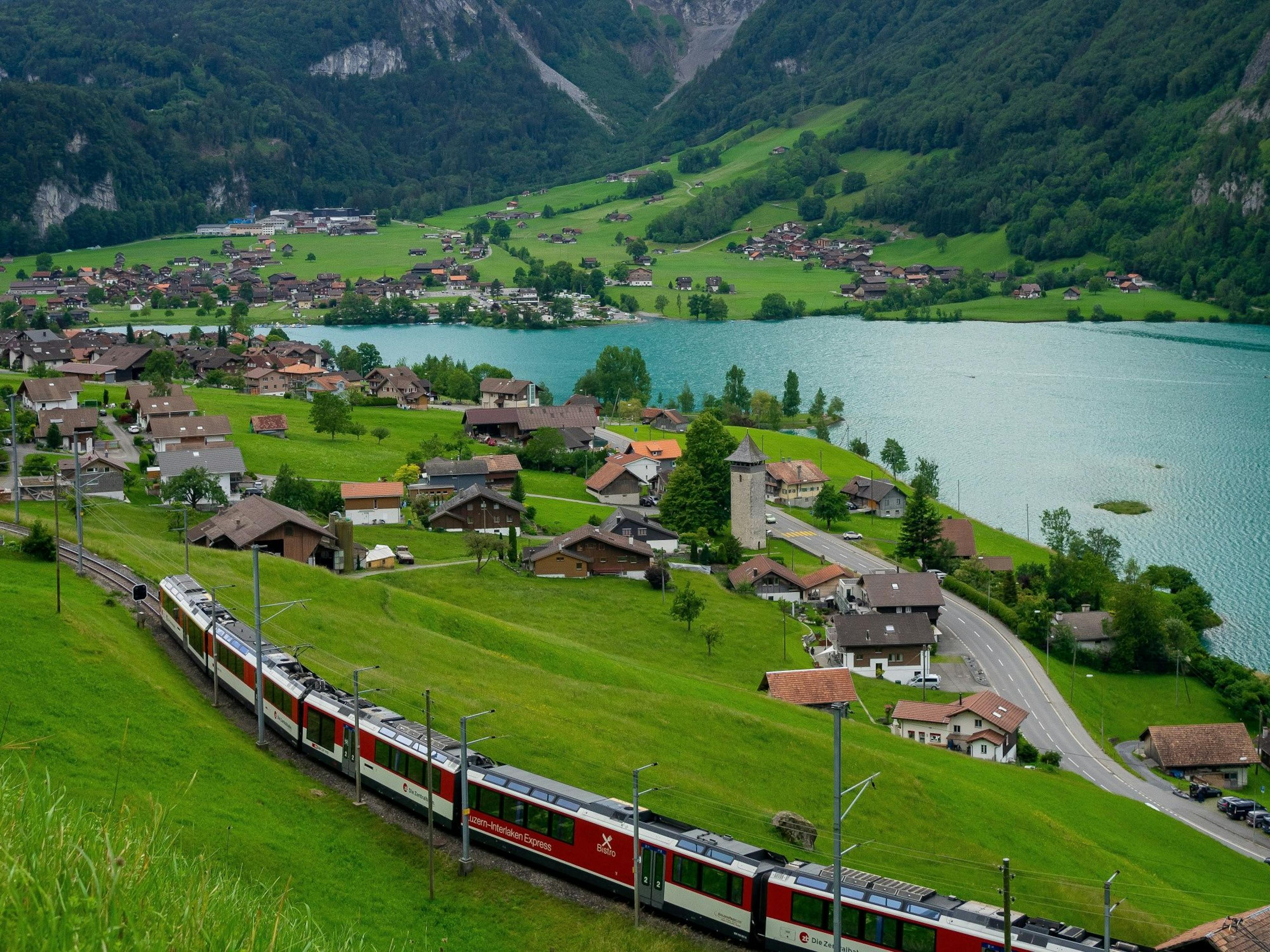
Ticket
Lucerne - Interlaken Express Ticket (without reservation)
booked 278 times
Why book with Swiss Activities?
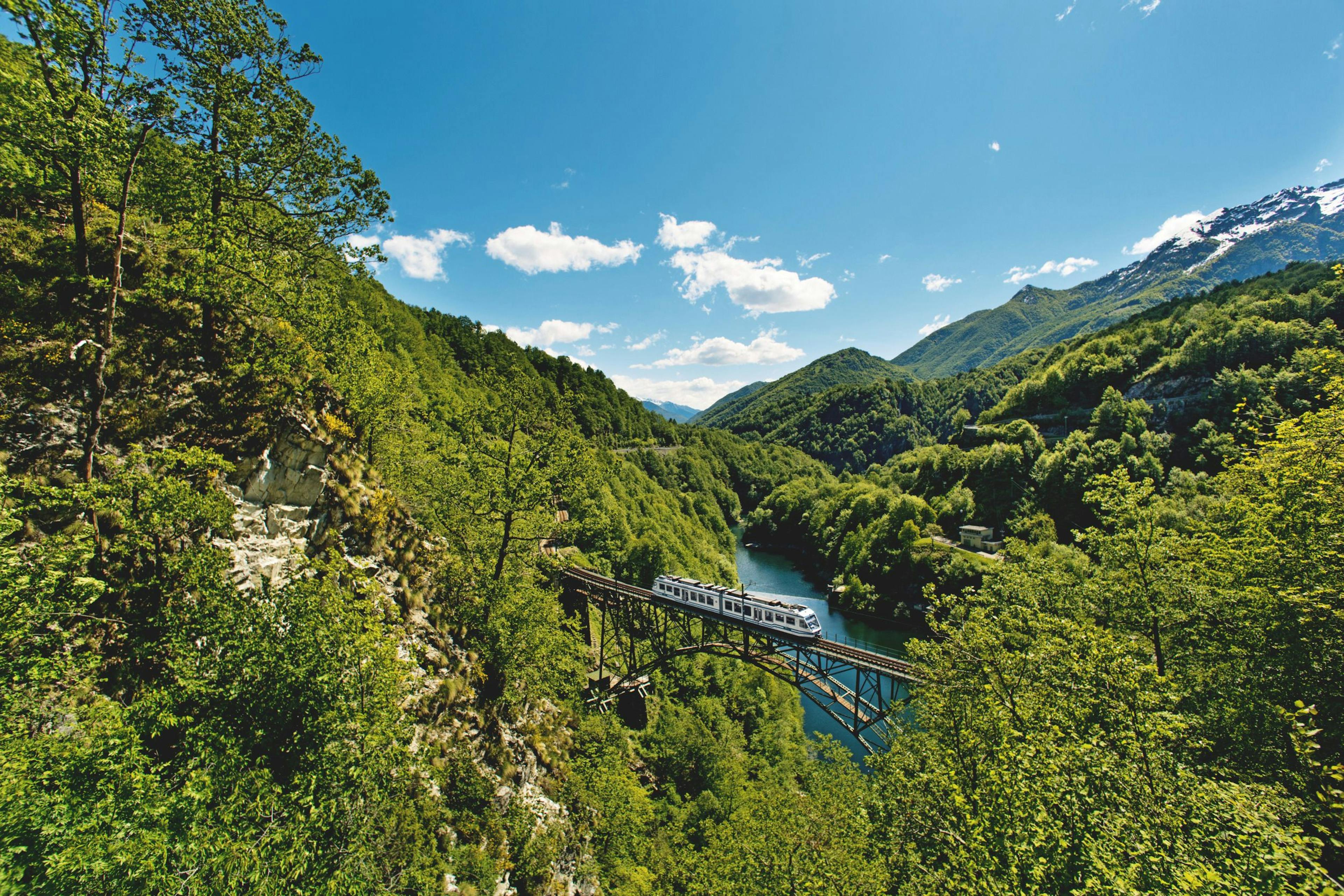
Ticket
Centovalli train ticket between Domodossola and Locarno
booked 6 times

Ticket
Voralpen Express Ticket from St. Gallen or Lucerne
booked 5 times

Ticket
High demandGolden Pass Express Ticket from Interlaken Ost or Montreux (without reservation)
booked 30 times

Ticket
Gotthard Panorama Express Ticket from Lucerne or Lugano (without seat reservation)
booked 110 times

Ticket
Glacier Express Ticket from St. Moritz or Zermatt (without reservation)
booked 21 times
We've already talked about the fact that Switzerland has a high affinity for trains as a means of transport in our article about public transport in Switzerland. But did you know that those over 5300 km of railway tracks serve more than just fast transportation from one place to another?
There are several railroad lines that you would love to travel several times in a row. Because that way you could take a closer look at the beautiful scenery that inevitably speeds past your windows. Be that the journey on the intercity train from Zurich to Chur, which passes mystical Lake Walensee. Or the route from Fribourg to Lausanne, where you get an incredible view over the Lavaux vineyards and Lake Geneva after the tunnel.
Train travel and beautiful views usually go hand in hand in Switzerland. If you're looking to embark on a train journey with a focus on these very views, there are some world-famous panoramic trains that will make your heart beat faster.
Swiss Activities Tips: Get he perfect support for planning your trip in the panorama train through Switzerland with the Train Tour App. Also, the panoramic trains are all covered by the Swiss Travel Pass and other railway passes for tourists.
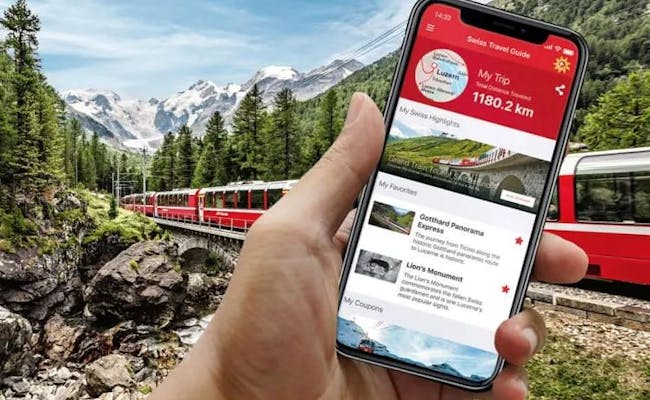 Plane deine Reise mit der Train Tour App (Foto: Swiss Travel System)
Plane deine Reise mit der Train Tour App (Foto: Swiss Travel System)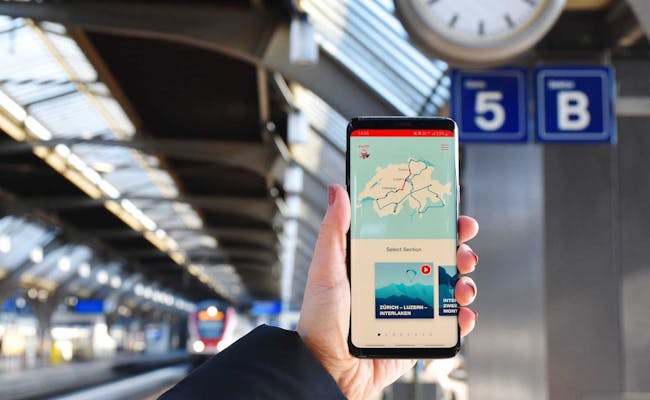 Züge in der Schweiz (Foto: Swiss Travel System)
Züge in der Schweiz (Foto: Swiss Travel System)The Glacier Express is called the "slowest express train in the world" and lives up to this title. It covers a distance of 291 km between Zermatt and St. Moritz, passes 91 tunnels and crosses 291 bridges. It takes no less than eight hours to do so. This results in an average speed of 36 km/h, which is roughly equivalent to the speed that a leatherback turtle can cover under water.
The Glacier Express is operated by the two railroad companies Matterhorn-Gotthard-Bahn (MGB) and Rhätische Bahn (RhB). The MGB operates the section between Zermatt and Disentis, while the part between Disentis and St. Moritz is operated by the RhB.
So if you're making your way from St. Moritz to Zermatt on the Glacier Express, you'll have more than enough time at turtle speed to get your fill of the enchanting scenery. Check out this Glacier Express review for more information on this scenic ride.
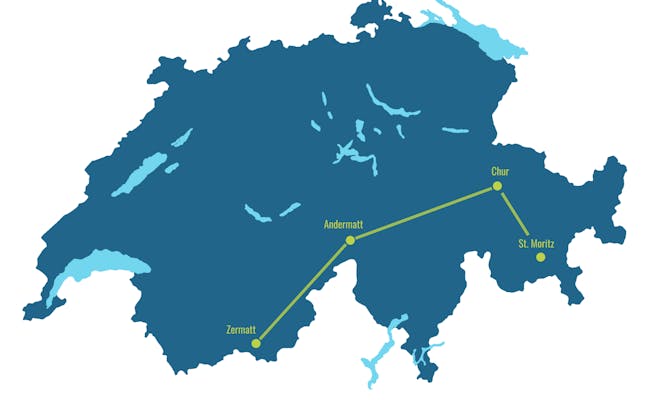 Route Glacier Express
Route Glacier Express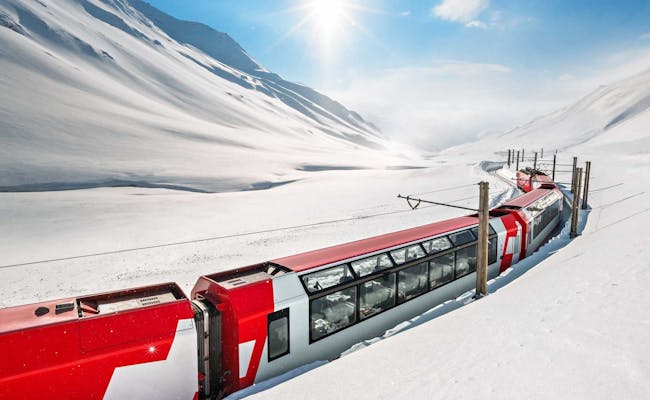 Glacier Express (Foto: Swiss Travel System)
Glacier Express (Foto: Swiss Travel System)The Glacier Express commutes between St. Moritz in the Engadine and Zermatt, the mountain village at the foot of the Matterhorn. Shortly after its departure in St. Moritz, the Glacier Express travels along the winding Albula line.
On this railroad line, the train passes through six viaducts and three helical tunnels to overcome the altitude between the Albula Pass and Filisur. It was included in the UNESCO World Heritage inventory in 2008. On this route, the train keeps changing the side of the valley and the direction. This does not make it easy to keep track of where you are. So keep a close look out the window.
This segment of the Glacier Express also includes the impressive Landwasser Viaduct, which leads directly from the bridge structure into a tunnel. The viaduct is 146 m long and 65 m high.
Next, the Glacier Express travels through the Rhine Gorge, also known as "Ruinaulta" or the "Swiss Grand Canyon". If you start the journey in St. Moritz, here you have the best view of the Rhine Gorge on the left side of the train.
After a quick break in Chur, the capital of the canton of Grisons, the journey continues across the Oberalp Pass via Disentis/Mustér to Andermatt in the canton of Uri. Up here, the Glacier Express overcomes its highest point and passes Lake Oberalp, 2044 meters above sea level.
Afterwards, it's more or less all downhill and along the River Rhone to Brig in the canton of Valais. After Brig, the Glacier Express makes another change of direction and begins its final ascent to Zermatt. Here, the Matterhorn hopefully waits impatiently for you and does not hide behind the clouds.
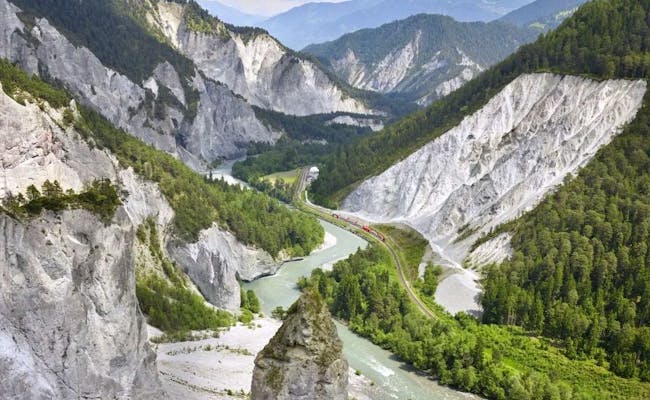 Rheinschlucht (Foto: MySwitzerland)
Rheinschlucht (Foto: MySwitzerland) Landwasser Viadukt (Foto: Swiss Travel System)
Landwasser Viadukt (Foto: Swiss Travel System)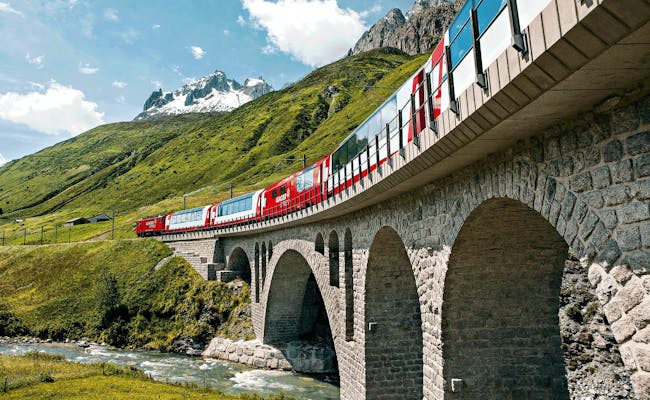 Glacier Express (Foto: Swiss Travel System)
Glacier Express (Foto: Swiss Travel System)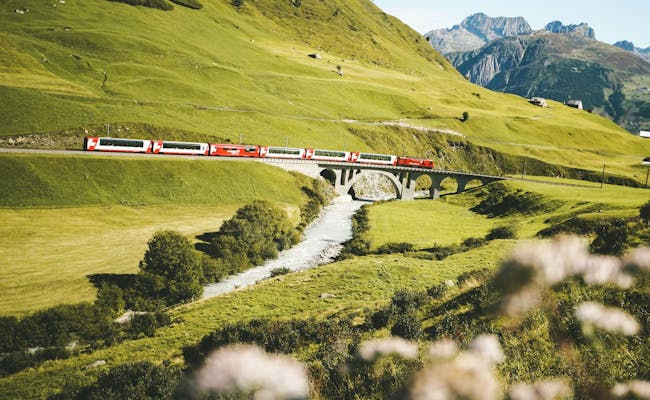 Glacier Express Panoramazug am Oberalppass (Foto: Swiss Travel System)
Glacier Express Panoramazug am Oberalppass (Foto: Swiss Travel System)With its 55 tunnels and 196 bridges, which the Bernina Express panorama train crosses and traverses on the 156 km between Chur and Tirano, you could call it the little brother of the Glacier Express. In terms of speed, the two roughly balance each other out, as the Bernina Express also glides along the rails at leather turtle speed.
What's special about the Bernina Express is that it crosses the Swiss border and you have to change means of transportation in between. After about four hours, the panoramic train of the Rhaetian Railway reaches Tirano in Italy. From there, the Bernina Express bus covers the remaining 90 km to Lugano.
Due to the fact that the Bernina Express crosses the Alps, you will be able to marvel at glaciers on this trip in the beginning and be surrounded by palm trees only a few hours later. A more contrasting train ride in such a short time will be hard to find.
Learn more about the Bernina Express in our extensive review we wrote about this panoramic train.
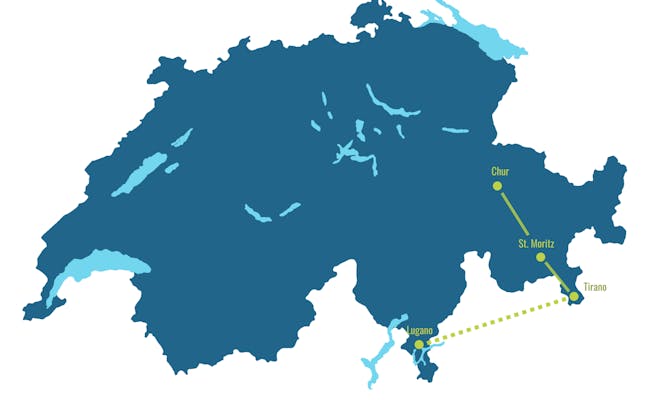 Route Bernina Express
Route Bernina Express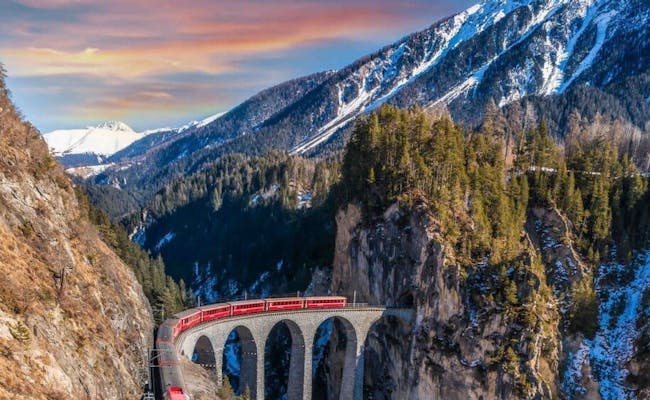 Bernina Express (Foto: Swiss Travel System)
Bernina Express (Foto: Swiss Travel System)The Bernina Express begins its journey in Chur and then shares its route with the Glacier Express until St. Moritz. Thus, this panoramic train also passes through the Rhine Gorge, over the Landwasser Viaduct and along the confusing Albula line into the Engadine.
From St. Moritz, the train climbs steeply up to Ospizio Bernina, which at 2253 meters above sea level is the highest point on the Bernina Express route. On the way there you have a wonderful view of the Morteratsch glacier as well as the ice-cold and deep blue Lago Bianco.
After this steep climb, it's all downhill. Literally.
Heading towards Italy, the Bernina Express travels over various viaducts, through the fertile Val Poschiavo, past Lago di Poschiavo and, shortly before crossing the border into Italy, across another highlight.
The circular viaduct in Brusio allows the train to overcome the required height on a small area and demonstrates for a moment the effect of centrifugal force.
In Campocologno the train crosses the border to Italy and ends in Tirano, a small town in Lombardy. From here, the Bernina Express bus takes you back to Switzerland in Lugano during summer. It takes three hours to drive through the Mediterranean Valtellina and past Lago di Como.
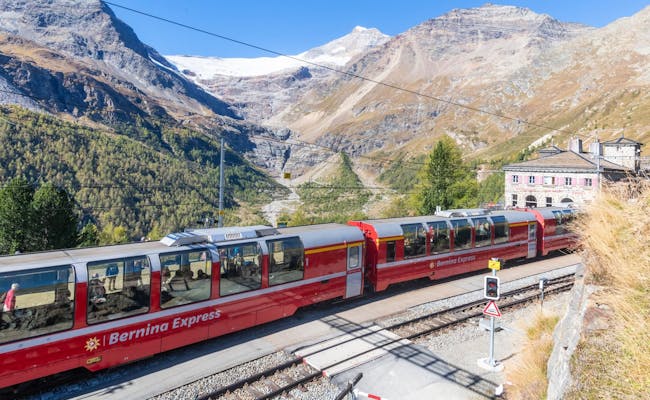 Der Bernina Express am Ospizio Bernina (Foto: Swiss Travel System)
Der Bernina Express am Ospizio Bernina (Foto: Swiss Travel System) Kreisviadukt in Brusio (Foto: MySwitzerland)
Kreisviadukt in Brusio (Foto: MySwitzerland)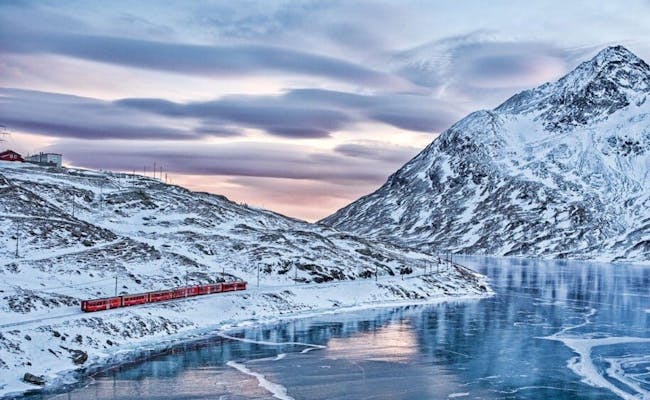 Bernina Express im Winter (Foto: Swiss Travel System)
Bernina Express im Winter (Foto: Swiss Travel System)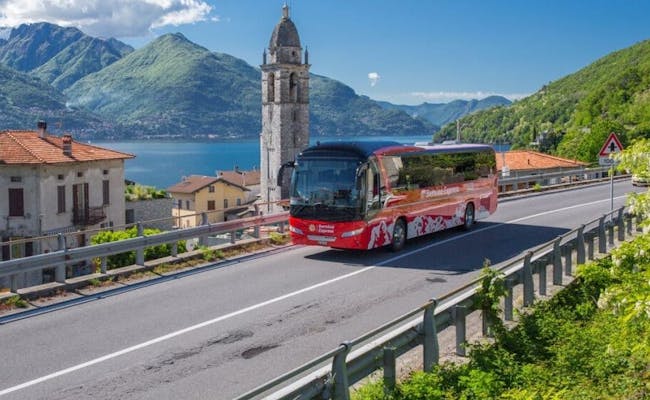 Bernina Express Bus (Foto: Swiss Travel System)
Bernina Express Bus (Foto: Swiss Travel System)The Golden Pass Line is a panoramic train route consisting of three individual stages. The first stage - operated by Zentralbahn - runs between Lucerne and Interlaken. After that, the BLS regional train takes over to Zweisimmen, from where the Golden Pass Panoramic finishes the third section to Montreux. All in all, this scenic route covers 191 km in roughly six hours.
The Golden Pass Line connects the German-speaking part of Switzerland with the French-speaking part and passes some important Swiss lakes along the way. These include Lake Lucerne, Lake Brienz, Lake Thun and Lake Geneva. You can also catch a glimpse of the Giessbach Falls along the way next to Lake Brienz.
Since the Golden Pass Line cuts right through the middle of Switzerland, it's especially easy to integrate it into your Switzerland itinerary.
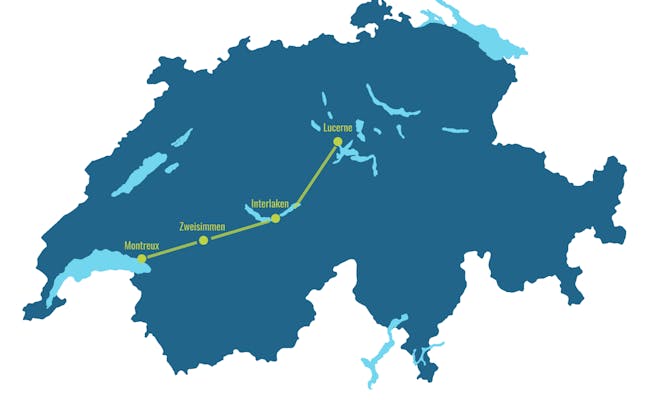 Route Golden Pass Line
Route Golden Pass Line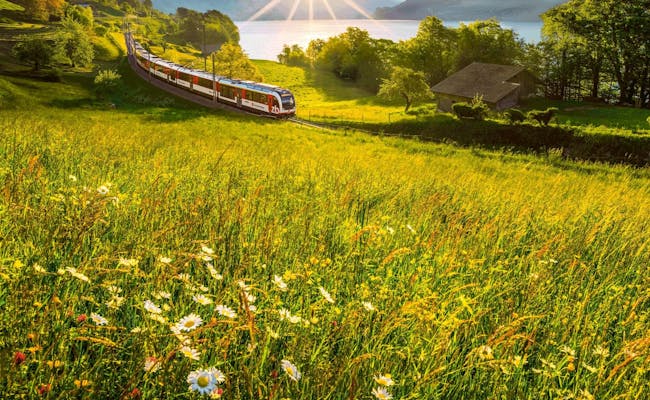 Golden Pass Line mit der Zentralbahn (Foto: Swiss Travel System)
Golden Pass Line mit der Zentralbahn (Foto: Swiss Travel System)Coming from the east, the Golden Pass Line starts in Lucerne. Before its ascent to the Brünig Pass at an altitude of just over 1000 meters, the train passes three smaller lakes: Lakes Alpnach, Sarner and Lungern. After crossing the Brünig Pass, it begins its descent towards Brienz and winds its way along Lake Brienz to Interlaken.
The views on this section are breathtaking. After Brienz, you can even catch a glimpse of the Giessbach Falls and the imposing Grand Hotel on the other side of the lake.
In Interlaken Ost, you'll need to transfer onto another train. This train changes the lakeside after Interlaken and travels along Lake Thun to Spiez. The subsequent journey through the Simmental invites you to slow down and dream. The train takes its dear time here and you can enjoy the narrow valley, the dark forests and the charming river.
After a flying change in Zweisimmen onto the Golden Pass Panoramic, the train continues uphill and through the Bernese Oberland to Gstaad. This ride offers another picture-perfect panorama. Green meadows, grazing cows, traditional wooden chalets and snowy peaks of the Alps in the background show you Switzerland as you imagined it.
On its final stretch to Montreux, the Golden Pass Line passes through the Vaud and Fribourg Alps and ultimately down through the vineyards to Lake Geneva. Here, an extremely contrasting journey comes to an end.
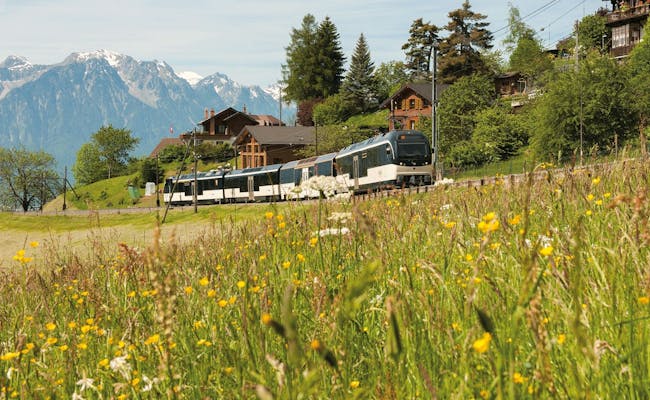 Golden Pass Line (Foto: Swiss Travel Systm)
Golden Pass Line (Foto: Swiss Travel Systm)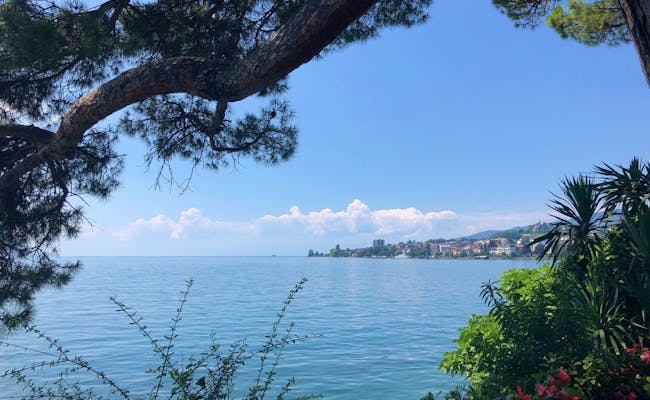 Montreux Riviera (Foto: Seraina Zellweger)
Montreux Riviera (Foto: Seraina Zellweger)The Gotthard Panorama Express is, in a way, a historic remnant of Switzerland's impressive railroad history. In summer 2016, the Gotthard Base Tunnel, the longest rail tunnel in the world, was inaugurated. It is 57 km long and shortens the journey to Ticino by 20%. Today, it's no longer necessary to travel via the traditional mountain route between Göschenen and Airolo. The faster route runs from Erstfeld directly to Bodio.
Until 2016, the mountain route was the only way to reach Ticino by train. Today, the traditional route is used by the Gotthard Panorama Express. This train takes its guests through the many helical tunnels and the Gotthard Tunnel, inaugurated in 1882, to the other side of the Alps. This panoramic journey between Lucerne and Lugano is combined with a steamboat-ride on Lake Lucerne and a train ride in the panoramic train through the old Gotthard tunnel.
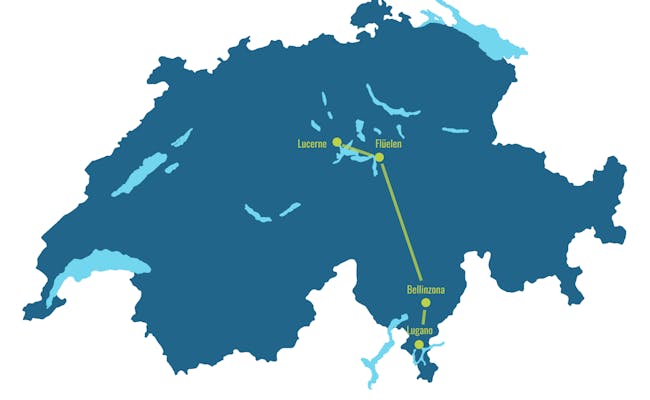 Route Gotthard Panorama Express
Route Gotthard Panorama Express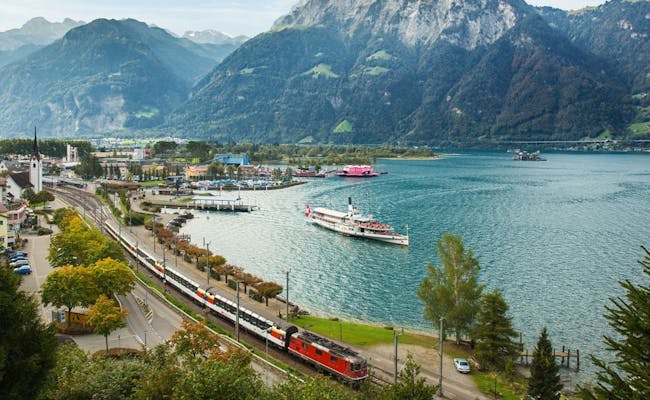 Gotthard Panorama Express am Vierwaldstättersee (Foto: Swiss Travel System)
Gotthard Panorama Express am Vierwaldstättersee (Foto: Swiss Travel System)The journey from north to south starts with a trip on the boat from Lucerne. On Lake Lucerne you will travel from Lucerne to Flüelen. This trip is served either by a historic paddle steamer or the modern motor ship "Diamant". On the way you will pass breathtaking landscapes and historical places like the Tell's Chapel or the Rütli meadow.
In Flüelen the panorama train is waiting for you and continues the journey southwards to Lugano. It climbs over various helical tunnels up to Göschenen, where the old Gotthard tunnel leads to Airolo. The special thing about this stretch is the "Chileli vo Wasse". The train passes this small chapel in Wassen three times.
To overcome the necessary altitude, the train makes some loops here and you have the opportunity on this section to view the cute chapel from different angles and altitudes. This "Chileli" is so famous among the Swiss population that the Swiss band "Lo & Leduc" even dedicated a song to it.
After crossing the original Gotthard tunnel, the descent follows through the Mediterranean Ticino countryside. You will pass the medieval castles of Bellinzona until you reach Lugano, where a southern flair with palm trees and Italian gelaterias awaits you.
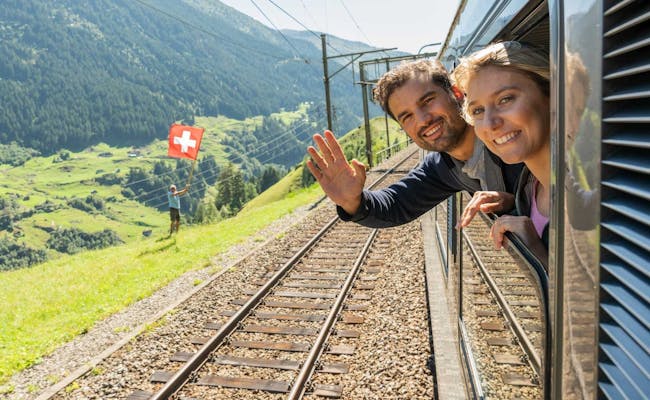 Unterwegs im Gotthard Panorama Express (Foto: Swiss Travel System)
Unterwegs im Gotthard Panorama Express (Foto: Swiss Travel System)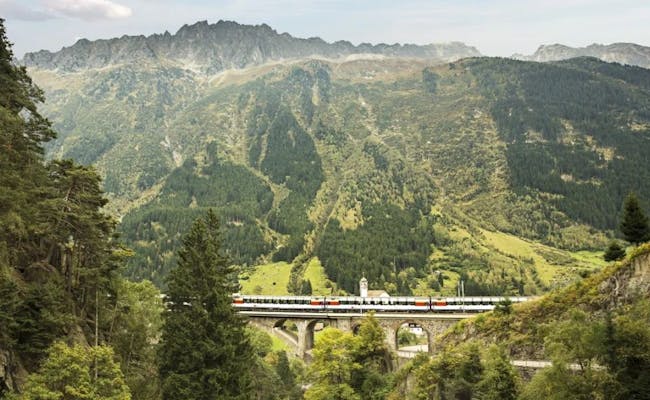 Das berühmte Chileli vo Wassen (Foto: MySwitzerland)
Das berühmte Chileli vo Wassen (Foto: MySwitzerland)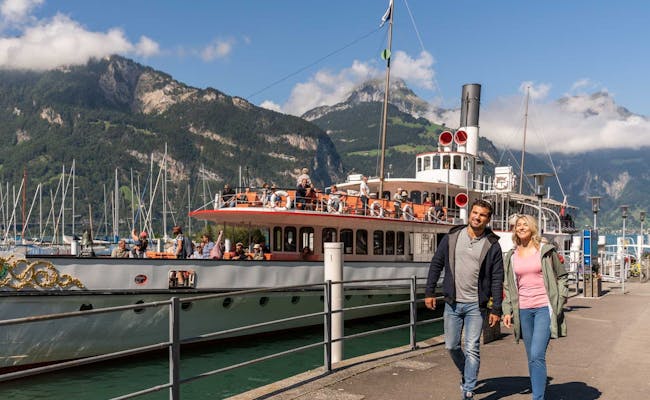 Schiff in Flüelen (Foto: Swiss Travel System)
Schiff in Flüelen (Foto: Swiss Travel System)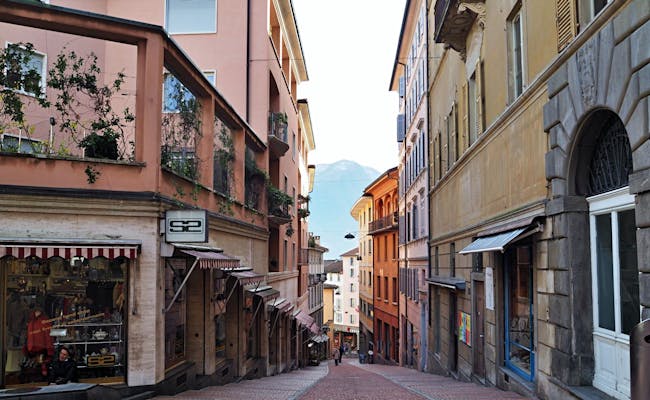 Lugano (Foto: Seraina Zellweger)
Lugano (Foto: Seraina Zellweger)The Voralpen Express is not a panoramic train in the true sense like the other candidates in this article. It neither has oversized panorama windows, nor is it specially designed for tourists. But it's the most comfortable and attractive connection between St. Gallen and Lucerne with beautiful views.
Originally, the Voralpen Express used to serve the route between Romanshorn on Lake Constance and Lucerne. In 2019, however, it was shortened and has since ended or started in St. Gallen.
On the one hand, it is used as a commuter train, but is equally popular with day-trippers due to the varied and scenic route. The Voralpen Express takes "only" just under two and a half hours to cover the approximately 125 km. With an average speed of 55 km/h, this puts it in the same category as the kangaroo.
Goodbye leatherback turtle.
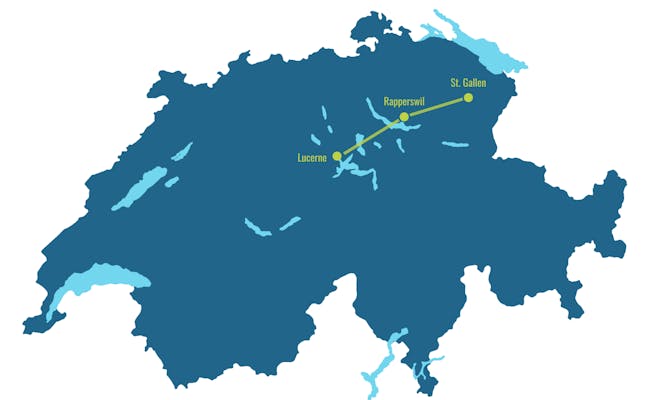 Route Voralpen Express
Route Voralpen Express Voralpen Express (Foto: Swiss Travel System)
Voralpen Express (Foto: Swiss Travel System)In the east, the Voralpen Express begins in the beautiful city of St. Gallen. Shortly after its start, it passes over the 99-meter-high Sitter Viaduct, the highest railroad viaduct in Switzerland. This is followed by another viaduct in Herisau, which scores with its unrestricted view over the Alpstein mountains. Afterwards, the train winds through green, hilly and typically eastern Swiss landscapes that pass by outside your window.
After two long tunnels through the Wasserfluh and the Ricken, the Voralpen Express arrives in Rapperswil on Lake Zurich. This pretty little town with its striking castle is located at the eastern end of the lake dam that leads across Lake Zurich to Pfäffikon. Along this dam is a wooden footbridge that forms part of the Camino de Santiago and is very popular for walking.
If you want to break up your trip, a short stay in Rapperswil followed by a quick walk along the footbridge to Pfäffikon might be a good idea. In Pfäffikon you can continue your journey on the Voralpen Express. From Pfäffikon the train climbs up the hill to Rothenthurm, where you'll pass the largest contiguous high moor area in Switzerland.
Afterwards, you'll be accompanied by more impressive views of the Alps. Soon Lake Zug and Lake Lucerne join the panorama. After a ride along the lake and one last stop at the Museum of Transport Lucerne you will arrive in the city of Lucerne.
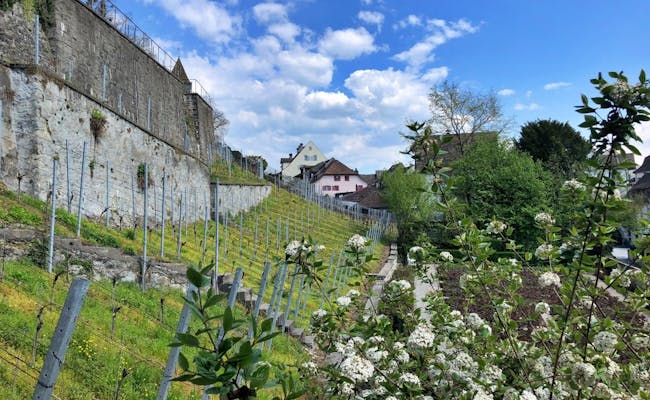 Rapperswil liegt auf dem Weg des Voralpen Express (Foto: Seraina Zellweger)
Rapperswil liegt auf dem Weg des Voralpen Express (Foto: Seraina Zellweger) Voralpen Express (Foto: Swiss Travel System)
Voralpen Express (Foto: Swiss Travel System)Granted, these five panoramic trains rightly enjoy a high popularity. But when you consider the several thousand kilometers of railway tracks in Switzerland, there are countless other scenic sections. These may be less well known, but some of them are also very impressive. So, should you be looking for a slightly "more ordinary" and less exclusive route, here's a small selection to finish this article:
In a country with 5300 km of railway tracks, you'll find more than enough train rides with stunning views that'll make your heart beat faster. So buy your ticket, grab a window seat and press your nose against the glass.
The train first travels through the Zimmerberg Base Tunnel. Afterwards, the railroad line to Pfäffikon runs directly along the western shore of Lake Zurich. This means you can enjoy the lake on the left-hand side of the direction of travel. As soon as the train has passed the Ziegelbrücke stop, it passes a lake again. It is the Walensee, which you can also see clearly on the left as far as Walenstadt.
On the right, however, you have a direct view of the Glarus Alps. After Sargans you will see the Pizol in the foreground.
The journey from Chur to Arosa takes an hour. After a leisurely ride through Chur, the train climbs high. The train climbs around 1000 meters in just 26 km. At the start, you can see the Dreibündenstein plateau with the Brambrüsch on the southern side. To the north is the Hochwang chain with the Hochwang at 2533 m above sea level as the highest point. You will see almost untouched nature all around. You quickly reach the mountain landscapes of Schanfigg. Schanfigg is the name of the elongated valley that leads directly to Arosa. The Langwieser Viaduct is a particular highlight of this ride. And it goes even higher: the train climbs up to 1739 m above sea level in Arosa and has thus covered 1155 meters in altitude since Chur. Now you have a view of the Weisshorn chain with the Weisshorn reaching 2653 m above sea level.
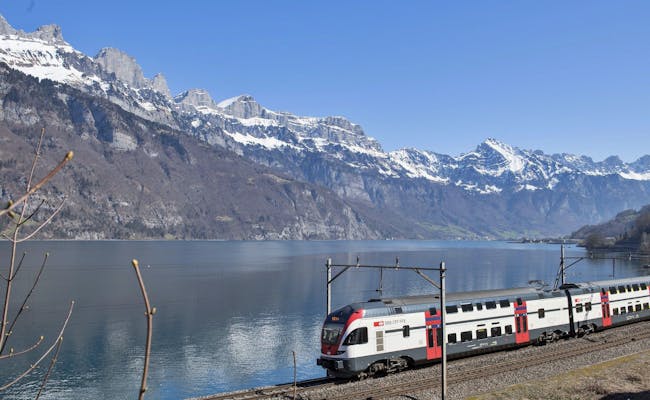 Zug am Walensee
Zug am Walensee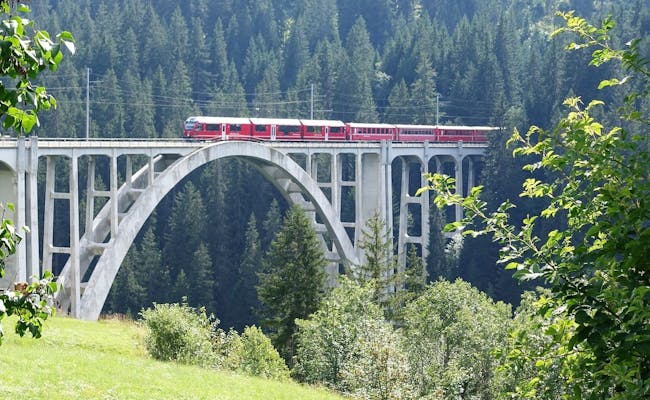 Fahrt über den Langwieser Viadukt
Fahrt über den Langwieser ViaduktThe InterRegio takes one hour from Chur to Filisur. Then take the regional train for about half an hour to Davos. Near Filisur, the Rhaetian Railway crosses the world-famous Landwasser Viaduct, which is 65 m high and 142 m long and enters a tunnel in a tight curve above the Landwasser Valley. Another viaduct awaits you on the rest of the route, the Wiesen Viaduct. It may not be as famous, but it is almost 89 m high. Both viaducts are only about 3 km apart.
The mountains that you see from Chur on the left (northern) side belong to the Plessuralpen. The Lenzerhorn stands out clearly at 2906 m above sea level. Then you can see the Strelakette of the Plessuralpen on the same side. The Guggernellgrat at 2810 m above sea level is clearly visible.
The other side of the window (from Chur to the right or south) shows you the striking rock of Piz Mitgel southwest of Filisur, which reaches 3159 m above sea level. The slightly higher Piz Ela, at 3339 m above sea level, peeps out behind it. Further along the railroad line towards Davos, the Albula Alps reveal themselves in all their glory.
Between Chur and Filisur, the Rhaetian Railway follows the same route as the train journey to Davos. From Filisur, however, it heads south and, after the Landwasser Viaduct, also has several helical tunnels along the way. They are located between Bergün and Preda and also look very spectacular from below. In winter, a very popular toboggan run runs from Preda to Bergün.
From the right-hand side of the window, you can see the peaks of Piz Bial (3061 m above sea level) and Piz Ot (3247 m above sea level) of the Albula Alps quite clearly in the direction of St. Moritz. Later, Piz Nair (3030 m above sea level) comes into view. On its eastern slope you will find the popular St. Moritz ski area of Corviglia.
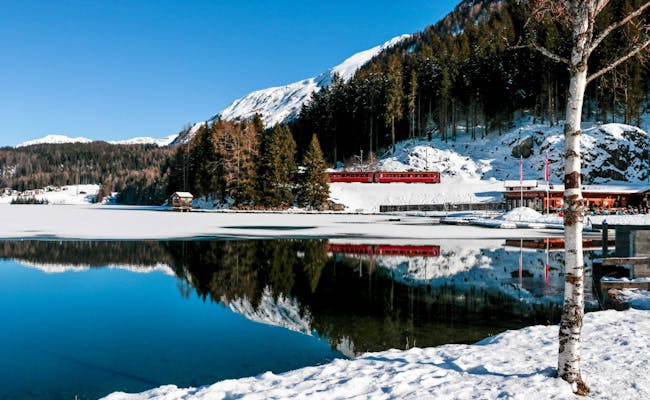 Zug in Davos
Zug in Davos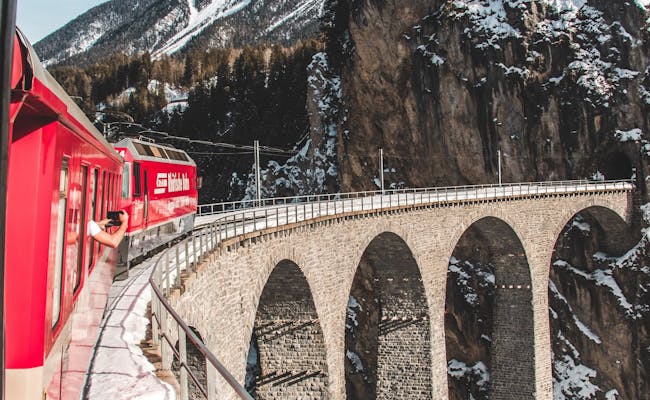 Fahrt über den Landwasserviadukt nach St Moritz
Fahrt über den Landwasserviadukt nach St MoritzThe Emmental lies in the hilly Bernese Plateau. The train runs from Bern via Langnau and also passes the Entlebuch, a huge biosphere that is a UNESCO World Heritage Site. To the west of Langnau (from Bern on the left-hand side of the journey) you can see the Blasenflue hill country, whose highest point is the Blasenflue at 1118 m above sea level. The train runs right through the middle of the 400 km² UNESCO Biosphere Entlebuch Nature Park. Shortly before Lucerne, you will see the striking Pilatus on the right.
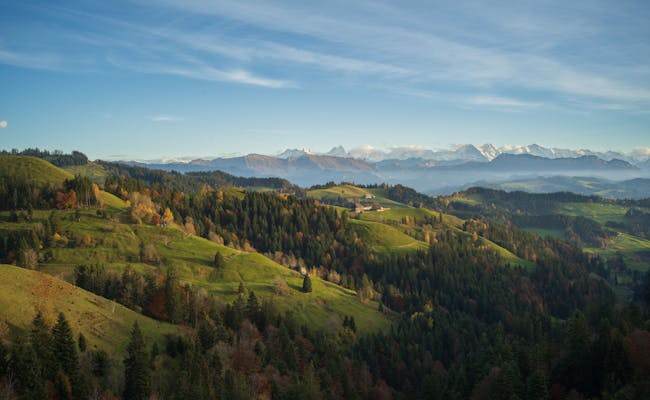 Lüderenalp im Emmental
Lüderenalp im Emmental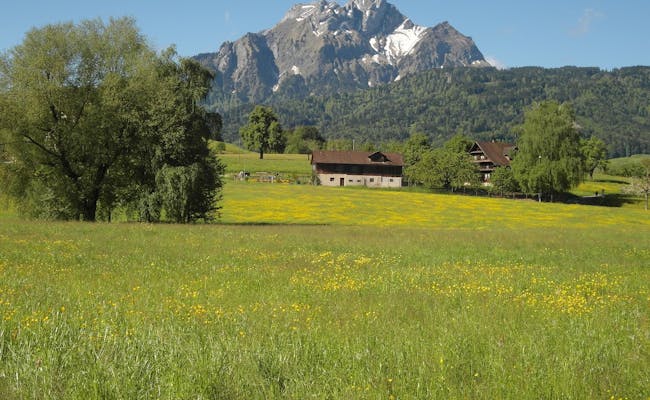 Pilatus aus der Entfernung
Pilatus aus der EntfernungThe train route between Schaffhausen and Romanshorn takes you through unique countryside and past a number of sights. Heading towards Romanshorn, you will see the Munot fortress towering high above the town right at the start of your journey in Schaffhausen. It has guarded the town of Schaffhausen since the 16th century. From the Feuerthalen train station, you have a more beautiful view on the left-hand side of the train. First you see the High Rhine, which you can see as far as the beautiful town of Stein am Rhein. After a brief look at the medieval houses on the other side of the Rhine, you will see the pilgrimage church of St. Otmar on a small island. The Lake Constance accompanies you on the left-hand side of the route for the rest of the way to Romanshorn. On the right-hand side, you will occasionally see vineyards.
This leisurely ride through the Appenzell countryside takes about an hour. As soon as you leave St. Gallen, a picture-book landscape begins on both sides of the train. Small villages with scattered buildings, interspersed with fields, meadows and forests. Heading towards Wasserauen, you will see the Hundwiler Höhi (1306 m above sea level), a popular vantage point, on the left. Later, on the other side, you can see the Alpstein massif in the distance. Its highest point is the summit of the Säntis(2502 m above sea level).
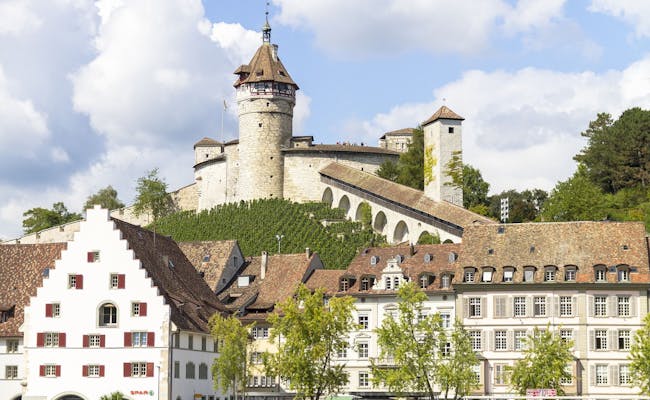 Schaffhausen Munot
Schaffhausen Munot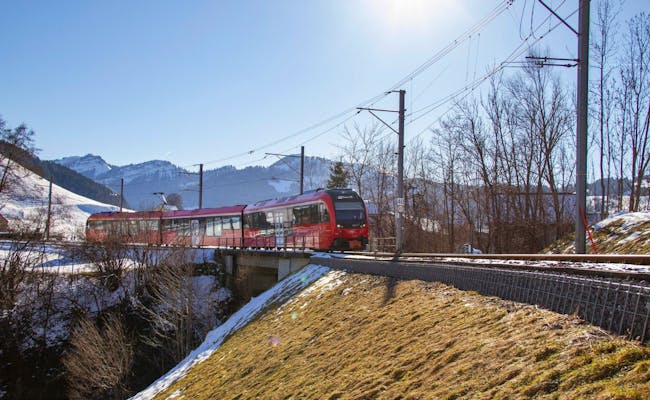 Zug im Appenzeller Land
Zug im Appenzeller LandThe train journey between Lausanne and Montreux is unique. You can't sit on the "wrong" side of the train. Heading towards Montreux, you have a view of the beautiful Lake Geneva with its ships and boats on the right-hand side. But it's not boring on the left-hand side either. Here you will discover the huge Lavaux wine-growing region. The growing area covers around 830 hectares and is spectacularly situated on terraces on Lake Geneva. It has been a UNESCO World Heritage Site since 2007. The vines here benefit from the reflection of the sun's rays that shine on Lake Geneva. Additional heat is stored in the stone walls around the vines.
You change trains twice on the way from Interlaken Ost to Zermatt, but the stunning scenery is your reward. The first stretch from Interlaken Ost takes you to Spiez. All along the route, you have a direct view of Lake Thun to the right and a good view of the Jungfrau region to the left. Incidentally, this route is part of the Golden Pass Express.
On the rest of the journey from Spiez to Visp and on to Zermatt, you travel right through the Bernese and Valais Alps. Between Visp and Zermatt, you cover part of the Glacier Express route. So you can look forward to wonderful views. In Zermatt, the four-thousand-metre peaks with the Matterhorn and the Dufourspitze await you.
 Das UNESCO Welterbegebiet Lavaux
Das UNESCO Welterbegebiet Lavaux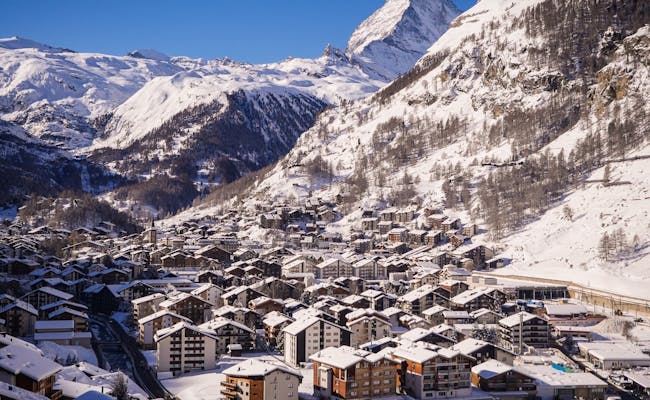 Zermatt im Winter
Zermatt im WinterTake the regional train between St. Moritz and Alp Grüm. On this route you travel through the Engadine Alps over the Bernina Pass. The alpine pass runs at 2235 m above sea level. Alp Grüm emerged from a Maiensäss and is a small settlement with a restaurant at the station. The view from its panoramic terrace is particularly spectacular.
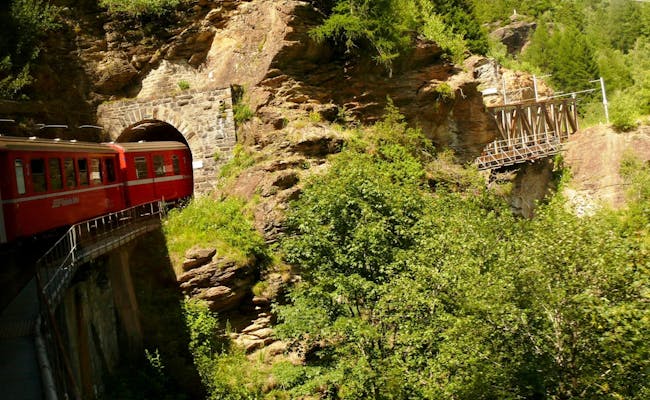 Rhätische Bahn kommt aus dem Tunnel (Foto: Elke Huber)
Rhätische Bahn kommt aus dem Tunnel (Foto: Elke Huber)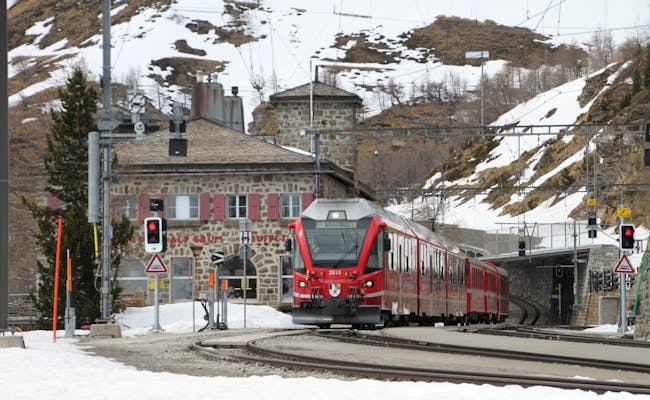 Alp Grüm Bahnstation mit Zug
Alp Grüm Bahnstation mit ZugThe Centovalli Railway connects Ticino with Italy and thus extends the Gotthard Railway line to the Simplon line in Domodossola.
The leisurely narrow-gauge railroad takes you through the "100 valleys" of the Centovalli and the adjoining Valle Vigezzo. You will pass through a number of tunnels and cross 83 bridges and viaducts. All around you will see a sleepy and largely untouched landscape with the River Melezza and beautiful waterfalls. Small Settlements are scattered across the landscape. It is not until you reach Italy that the villages through which the little train passes become somewhat larger. And you will notice that there are many churches along the route. The ride on the little train is a special experience.
In a country with 5300 km of tracks, you will find one or two views on most train journeys that will make your heart beat faster. So buy a ticket, grab a window seat and press your nose against the window.
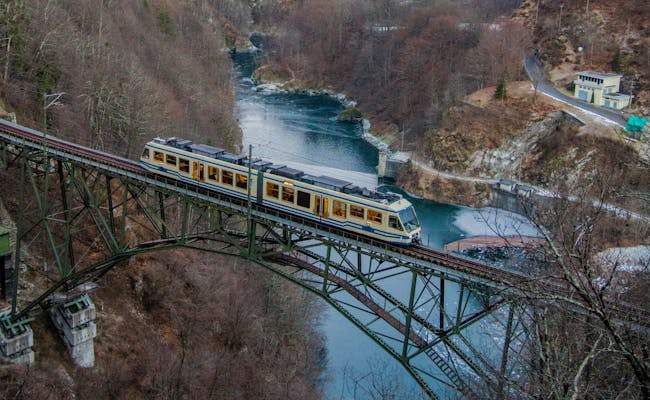 Centovalli Bahn in Camedo (Foto Schweiz Tourismus,© FART, Christian Guerra)
Centovalli Bahn in Camedo (Foto Schweiz Tourismus,© FART, Christian Guerra) Centovalli Bahn in Intragna (Switzerland Tourism, Marcus Gyger)
Centovalli Bahn in Intragna (Switzerland Tourism, Marcus Gyger)